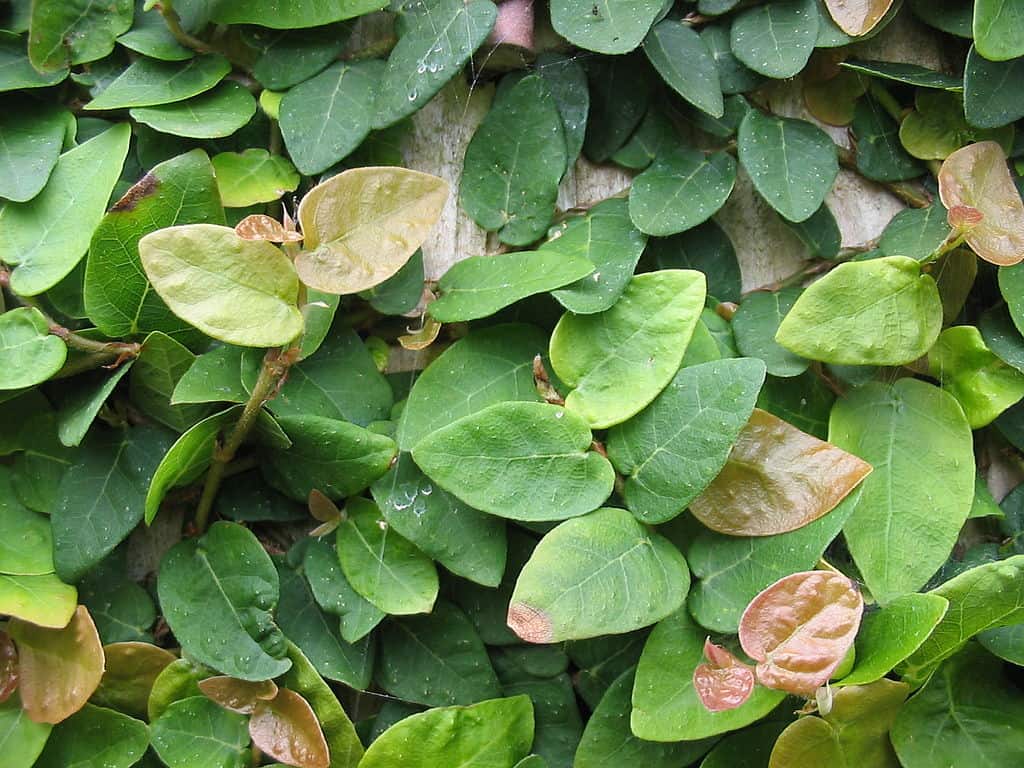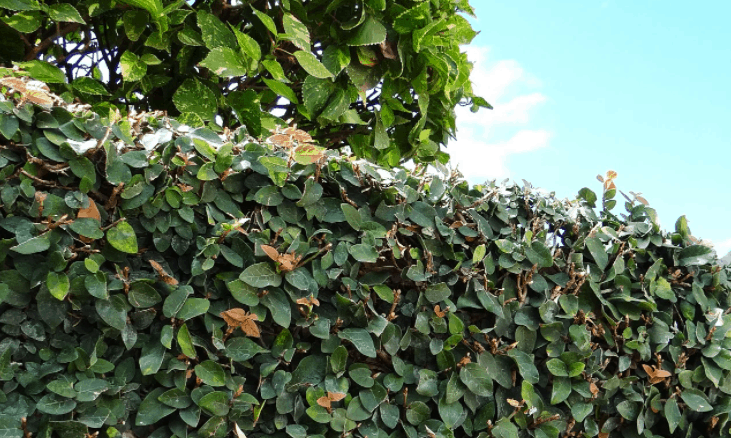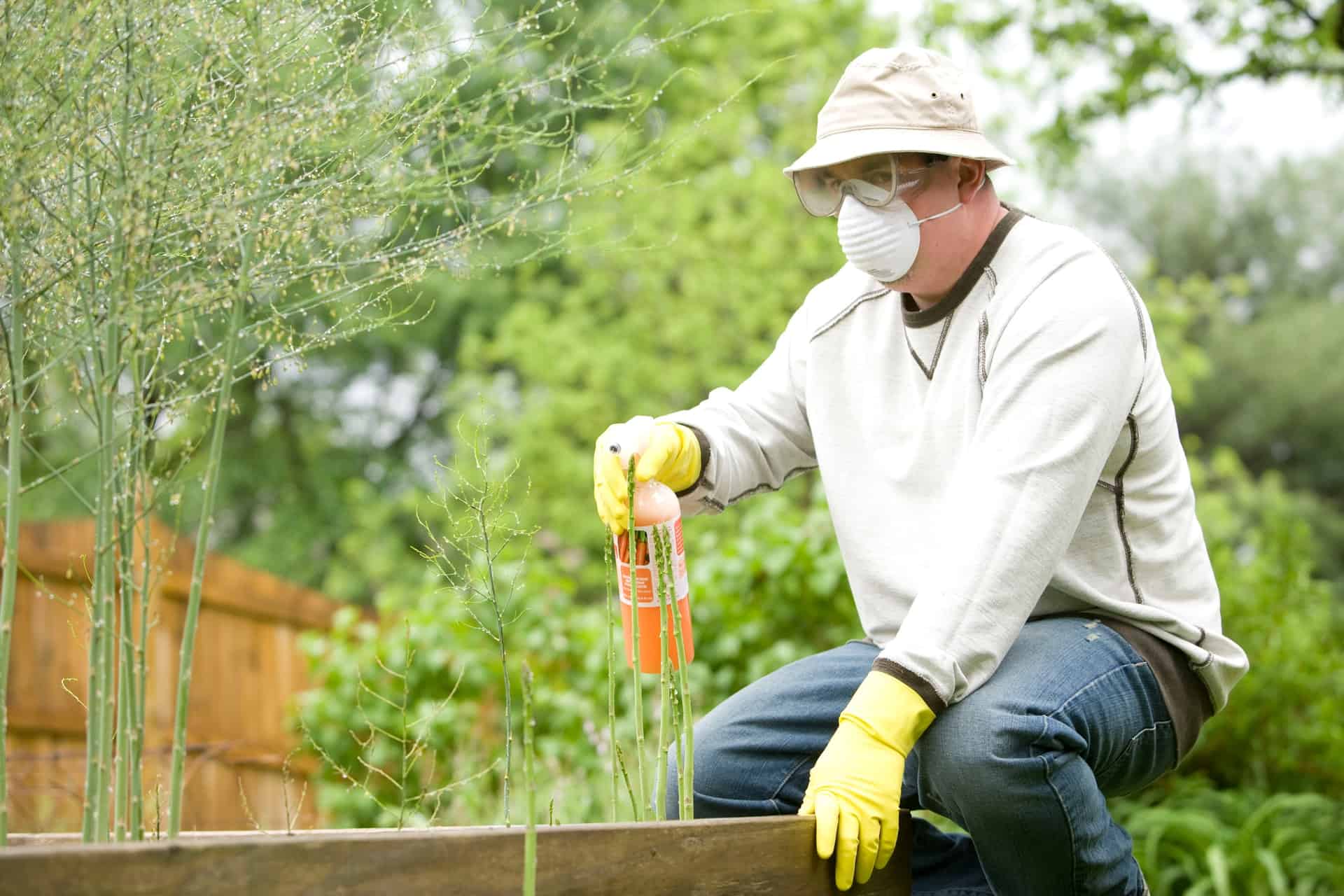- Ficus Pumila: Is This Vining Plant Too Needy For Your Time? - August 29, 2021
- Peperomia Frost: Why Peperomia Caperata Is The Perfect Indoor Plant - August 19, 2021
- Wax Begonia: Can Begonia Semperflorens Survive At Home? - August 18, 2021
Commonly known as creeping or climbing fig, Ficus Pumila can be grown outdoors as a climbing vine or kept indoors as an ornamental houseplant. Climbing fig originates from East Asia, though it now finds itself in many people’s homes worldwide. Its lush green foliage cascades over the edge of plant pots or climbs up walls, much like English ivy.
However, this particular evergreen is hardier than its English counterpart and can withstand a significant amount of trimming. It’s a good job, too, because it can reach lengths of up to fifteen feet!
Whether you’re a keen indoor or outdoor gardener, climbing fig brings a lot to the table. In this handy guide, we cover everything you need to know about the lush climbing fig plant, including identifying it, propagating it, and maintaining it.
How to Identify Ficus Pumila
Climbing fig plants might look similar to other evergreen climbers at first, but once you get to know them, it’s easy to spot the subtle differences that really make them stand out. Here are some key features:
- Ovate, heart-shaped leaves of rich green color, usually about an inch in length.
- Wiry, wood-like stems.
- Leaves with a crinkled texture and prominent veins.
- A height of up to 15 feet.
- Vines that spill over the edge of pots and hanging baskets.
One thing to be aware of in climbing fig plants is that their appearance often changes over time. When they are young, their leaves are extremely silky; as they mature, these same leaves become much more leathery. Likewise, the vines become tougher and more woody.

How to Grow Ficus Pumila From Seed
One specific insect only pollinates the climbing fig plant in its natural habitat: the fig wasp. However, it is still sometimes possible to purchase seeds online, and growing this plant can be tremendously rewarding. Here’s how to go about it.
- To prevent disease, firstly, sterilize your growing pots and select suitable soil.
- Moisten the soil and sow the seeds according to the instructions on the packet.
- Climbing fig plants love humidity, so you will need to ensure the soil stays moist throughout this process. We recommend using a mister.
- Keep the seeds in a warm place until they germinate. Climbing fig plants aren’t too picky about light levels (though you should aim to keep them out of the direct sun), but to maintain an appropriate level of humidity, use a terrarium, growing dome, or even a greenhouse.
Interesting Fact: climbing fig plants that are grown outside will sometimes yield fruit. This comes in the form of little bells that start a pale green color and mature to a deep purple. These fruits are often sold in Asian markets after being processed into a gel called ai-yu jelly.
How to Propagate Ficus Pumila
The best way to grow your own climbing fig plant is by propagating from an existing plant. For best results, propagate at the beginning of Spring. Here’s how!
- Water the plant you are going to propagate from in good time for the moisture to be absorbed.
- We recommend using a mixed soil consisting of two parts perlite, two parts sand, and one part compost. Use a pot with sufficient drainage holes, as this will be crucial for your plant’s continued success.
- Use pruning shears or sharp scissors to take cuttings that are approximately 4 inches long. Cut just below the leaves.
- Get rid of any leaves at the bottom of your cuttings, and for the best results, dip the ends into rooting hormone powder.
- Your cuttings should be placed into the soil with the top half sticking up and all leaves above soil level.
- Use a humidity dome to provide your climbing fig plants with the best possible growing conditions.
- Temperature permitting, you can place your cuttings outside in their new pots. However, if you keep them indoors, place them in an east-facing window or somewhere warm where they will receive plenty of indirect sunlight.
- It will take about 6 weeks for your cuttings to grow roots, providing you keep them watered and moist. At this point, remove the humidity dome.
Ficus Pumila Growing Conditions
For a healthy and happy climbing fig plant, the conditions – particularly humidity levels – need to be just right. That being said, Ficus Pumila is adapted to outdoor conditions where it can grow rapidly; for this reason, it will only last a few years in a pot.
So, what conditions make for a happy climbing fig plant? Indoor temperatures should be kept between 65-75°F, while humidity should drop no lower than 50%. Indoor air can often become dry during the winter months, so we recommend investing in a humidifier.
How to Plant Ficus Pumila

Climbing fig plants tend to grow pretty quickly, so they might need repotting more often than you’d expect. It’s best to do this slowly, increasing pot size in small amounts. Here’s how to go about repotting:
- Gently remove your climbing fig from its current pot, dusting off any excess soil.
- Select a new pot with sufficient drainage holes (if you need help choosing, check out our guide to the best planters and pots).
- Place your climbing fig plant into the new pot at the same depth it sat in the old one.
- Fill the rest of the space with soil and water the plant.
Ficus Pumila Potting & Soil
One of the greatest things about the creeping fig plant is that it can grow in various soils and light levels. While any soil-based potting mix should yield successful results, we recommend this Miracle-Gro moisture control potting mix, which protects from over and under-watering. In addition, your soil pH should be neutral to acidic.
When you select a pot, you should bear in mind that it should be proportionate in size to that of your climbing fig plant. Here you can find our guide to the best and most affordable pots and planters.
Ficus Pumila Water Requirements
Ensure the soil stays consistently moist throughout fall. During winter, you should water your climbing fig less; a good rule of thumb is to allow the top half of the soil to dry out before watering.
If the soil becomes waterlogged, this can quickly lead to problems for your climbing fig plant. The first sign of overwatering is yellow leaves, but this can easily be avoided by using a pot with plenty of drainage holes and the moisture-controlling soil we recommended earlier.
Sometimes it can be a challenge trying to remember when to water your plants. Luckily, there are several excellent phone apps you can download to help you with all aspects of plant care.
Ficus Pumila Light Requirements
Climbing fig plants prefer bright but indirect sunlight. Fortunately, they can also tolerate low light levels, which makes them easier to care for as houseplants, though growth is likely to be considerably slower in these conditions. However, you should avoid placing your climbing fig plant in direct sunlight, as this can cause irreparable damage.
Read More:
Ficus Pumila Fertilizer

Your climbing fig plant does not require fertilizer to continue growing, but if you really want it to flourish, you should fertilize it once a month during spring and fall.
Organic is always the best way forward when it comes to choosing a fertilizer. By including manure and other nutrient-rich substances in your plant’s soil, you eliminate the need for liquid food. This is especially handy if you lead a busy lifestyle and sometimes forget to keep up a regular plant care routine.
Additionally, there are a few organic liquid fertilizers available online. Our favorite non-liquid fertilizer is this nutrient dense plant food.
Best Ficus Pumila Companion Plantings
If you keep your climbing fig plant outside, there are a few similar plants you might want to use as companions. For example, star jasmine is an evergreen vine with beautiful white flowers. Philodendron Brasil also has equally quaint, attractive foliage.
If your climbing fig plant is a house plant, its lush green foliage will look pleasing beside succulent plants. There are so many to choose from, and most are extremely low maintenance. We’ve created a guide to help you select the right succulent for you. We also have an article that will help you get to know different types of indoor plants.
Ficus Pumila Diseases and Common Problems
The good news is that climbing fig plants are actually remarkably resistant to disease; most issues arise from insects. Here are a few of the most common:
Pests
- Aphids (Aphidoidea). These pests suck the sap out of plants.
- Mealybugs (Pseudococcidae). Make sure you regularly examine the roots of your climbing fig to catch these insects early.
- Scale (Coccoidea). Like aphids, scale insects feed on the plant’s sap. They can be difficult to spot because they become immobile after latching on.

Although it’s certainly true that climbing fig plants are resistant to disease, overwatering can still lead to root rot and sometimes fungal infections. You must be careful to provide your plant with the correct amount of water and use a pot that facilitates sufficient drainage.
Ficus Pumila Treatments and Maintenance
You can purchase insecticidal soap sprays to deal with pests. When doing so, make sure all affected material is removed from the plant. In the unlikely event that your climbing fig plant develops a fungal infection, you should treat it using fungicides that are readily available online.
You will need to carry out some pruning to keep your climbing fig in good condition, particularly if it is being kept indoors. Trimming excess plant matter will promote new growth while removing damaged or unhealthy leaves will prevent disease.
Where to Buy Ficus Pumila Seeds Online
When growing Ficus Pumila, most people prefer to propagate from cuttings rather than seeds, which means it can be difficult to find the seeds for sale online. However, we recommend searching on Amazon.
Where to Buy Mature Ficus Pumila Online
You can purchase mature climbing fig plants on Amazon or find them at your local garden center.
FAQs
Question: How Fast Does Climbing Fig Grow?
Answer: The answer is incredibly fast! It has sometimes been known to cover an entire wall in just a couple of years.
Question: Why Have the Leaves of my Climbing Fig Plant Gone Brown?
Answer: The likely culprit is air humidity – specifically, a lack of it! Dry air causes the leaves of climbing fig plants to turn brown and crispy. To combat this, you should invest in an air humidifier that will allow you to control your plant’s environment, giving it the optimum conditions in which to thrive.
Question: Why Does my Climbing Fig Keep Losing Leaves?
Answer: During the winter, this shouldn’t be a cause for concern. However, if your plant is losing leaves at a different time of the year, there could be several causes:
• Compacted soil. If the soil is packed too tightly around the roots, it becomes difficult to breathe, and they cannot transport water as they normally would.
• Excessive watering. This can cause root rot which has a knock-on effect on leaf health.
• Lack of sunlight. This is an easy fix – simply move your plant into a sunnier spot.
Question: Is Climbing Fig Poisonous?
Answer: Unfortunately, the answer to this question is yes. The sap that Ficus Pumila excreteshas an inflammatory effect. If you are carrying out any pruning, try to wear protective gardening gloves.
Question: What Varieties of Climbing Figs are There?
Answer: There are a few different varieties available. One of these cultivars is ‘snowflake,’ which has variegated, ivy-like leaves. Others are oak-leaf fig and curly-leaf fig.

